
Leaving Rome, where
we hadn't driven since arriving, was an adventure. Driving south on S148,
a two-lane highway, we experienced a range of emotions: from scared to
death to dumbfounded to annoyed, and back again. Cars and motorcycles
would pass with no regard for oncoming traffic. The middle of the road
got as much action as the two lanes. At red lights, cars and bikes would
go around us, on the left and right, and swarm as close to the light as
possible. And no one seemed to care. No road rage in Italy, apparently.
This took some getting used to …
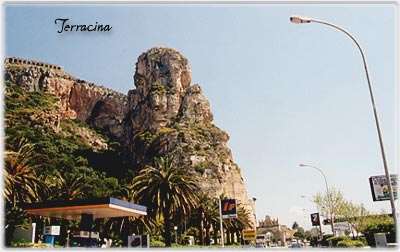 We
would get our first look at the Mediterranean in Terracina, a pretty coastal
town with a nice mix of narrow, old streets and dramatic limestone outcroppings,
upthrust into giant pedestals.
We
would get our first look at the Mediterranean in Terracina, a pretty coastal
town with a nice mix of narrow, old streets and dramatic limestone outcroppings,
upthrust into giant pedestals.
Gaeta was the next sizable town, situated on a peninsula that overlooked a teal bay and mountains. This was a hot, sunny Labor Day, and loads of people were crowding into the beach areas. [Gaeta panorama]
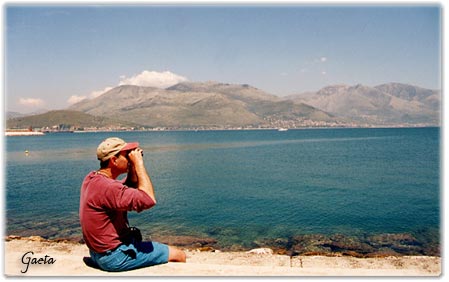 |
 |
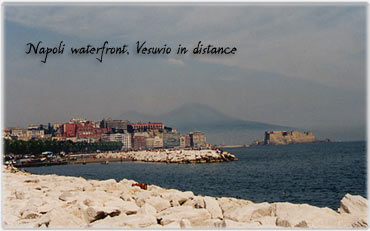 We
stayed along the coast, through wild and crazy Napoli. We had been warned
of thieves reaching through car windows to grab purses, and other such
antics, so were on guard. Peter did well driving the poor, bumpy roadway
in chaotic circumstances. He was becoming Italian-like in driving style
— a must for survival.
We
stayed along the coast, through wild and crazy Napoli. We had been warned
of thieves reaching through car windows to grab purses, and other such
antics, so were on guard. Peter did well driving the poor, bumpy roadway
in chaotic circumstances. He was becoming Italian-like in driving style
— a must for survival.
Napoli is set so spectacularly, with mountains forming its land borders (Vesuvio looming just south) and the Bay of Napoli forming a crescent-shaped sea boundary.
In 1911, my grandfather Domenico had emigrated from this spot. At age 18, he boarded the Germania in the port of Napoli and travelled to Ellis Island. I had wanted to at least see the area, but it was not on the itinerary. Napoli has had a bad reputation because of crime and grime, but apparently has cleaned up its act.
We somehow found our way to the Autostrada, and the Torre del Greco exit to Vesuvio. A 17-mile road went most of the way up — we wanted a look at the still-active volcano. There are two summits, Monte Somma at 3,174 feet and Vesuvio proper at 4,190 feet. Its last major eruption was in 1944, with nothing more than smoke for activity since then. But it has a very destructive past, starting in 79 AD when an eruption buried Herculaneum and Pompei. And towns nearer like Torre del Greco and Torre Annunziata have been wiped out repeatedly … not places you'd want your vacation home.
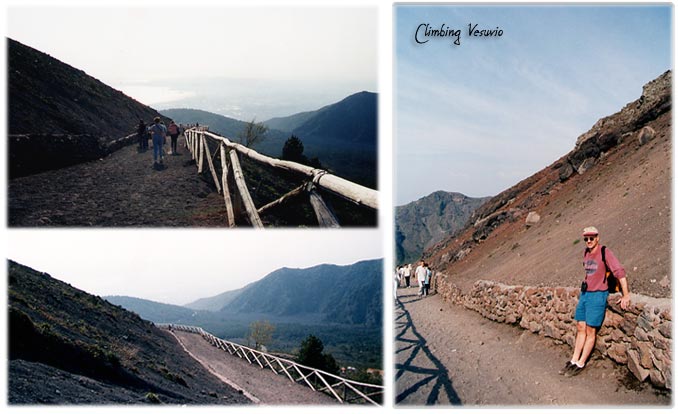
We climbed and switchbacked our way up, watching and waiting as tour busses would hold up traffic on the hairpin turns, backing up and maneuvering to make the sharp corners. As the road ended, a souvenir shack was positioned at the parking area entry. We were barely able to squeeze through the vehicles and crowd massed about. Looking up, we saw a zigzaggy, dusty trail. A good distance and steep in parts … we headed up .. along with Italians of all shapes, sizes and ages. It amazed me to see older people with street shoes, slowly and successfully climbing the mountain — must be all that good pasta and wine.
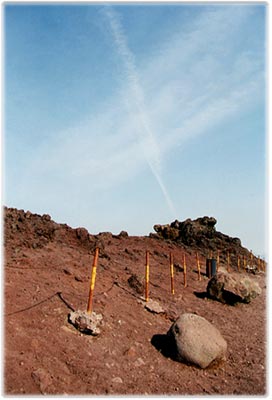 |
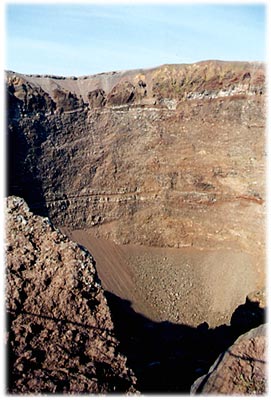 |
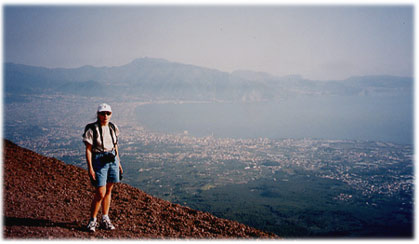 Just
before getting to the summit, another souvenir hut, and what's this? An
"entry" fee (10,000 lire) had to be paid to go further … now that's a
neat trick. [Vesuvio
panorama] There was a stunning panoramic vista from the volcano:
the Bay of Napoli, the city and surrounding area, the length of the Sorrentine
peninsula to the south and even Capri, in the haze. [Vesuvio
vista]
Just
before getting to the summit, another souvenir hut, and what's this? An
"entry" fee (10,000 lire) had to be paid to go further … now that's a
neat trick. [Vesuvio
panorama] There was a stunning panoramic vista from the volcano:
the Bay of Napoli, the city and surrounding area, the length of the Sorrentine
peninsula to the south and even Capri, in the haze. [Vesuvio
vista]
The crater is barren and massive: 655 ft deep and 1970 feet in diameter. It's mostly brown but had some nice multi-tone striations along the top edges. We saw a small plume of smoke coming from a crack just below the rim we were craning over. Not nearly as pretty as Haleakala, and much more ominous. After spending a while enjoying being on top of a volcano in Italy, we tromped back down the dusty trail.
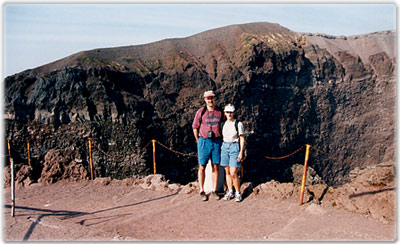
Our destination for the night was modern-day Pompei, just a few miles to the south. After navigating through a crazy intersection just off the Autostrada, where a busy street, the highway exit ramp and the entrance to the ruins, all converged, we drove across town to our hotel on the south side. First a double take — is this Italy or Miami Beach? We enjoyed the pleasant, colorful environs of the modern hotel, and later a great dinner in a downtown restaurant.
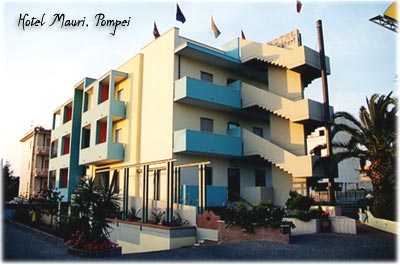 |
 |
The next morning we were off to Scavi di Pompei — the ruins of ancient Pompei ... along with a few thousand others — mostly tour groups of foreign seniors and Italian school kids.
The early residents
of Pompei were pretty unlucky — they were still recovering from a
massive earthquake in 62 AD when Vesuvio erupted in 79 AD, and buried
the town with 20+ feet of cinders.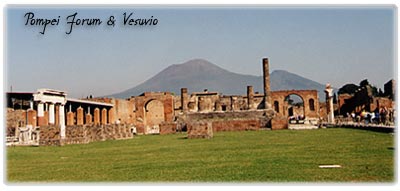 The town had been flourishing community of 25,000, with residents active
in trade and politics; it was also a popular resort area for well-to-do
Romans.
The town had been flourishing community of 25,000, with residents active
in trade and politics; it was also a popular resort area for well-to-do
Romans.
Pompeians had yet to settle on a standard building style, so there were different materials and methods used; and different kinds of homes, from very spartan to pretty ritzy.
There were also different styles of art. We saw lot of the bold, rich Pompeian red color used ... it was a particular favorite. But somehow, the place comes together as a fascinating and beautiful whole, only discovered in 1750. Many of the most important artifacts excavated are in the Museo Archeologico Nazionale in Napoli. [Pompei panorama]
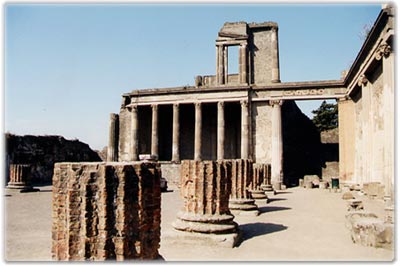
![]() We
managed to find space away from the tour group masses, to enjoy Pompei
by ourselves. The Basilica, a court of law, was stately and serene with
elegant column remnants. [Basilica
panorama] Next to that is the Forum, a large rectangular expanse
that is the oldest and highest section of Pompei — the center of
life in the ancient town. We walked the cobblestoned streets, across which
were raised stepping stones so pedestrians could avoid flooded roadways;
the gaps between them spaced to accommodate chariot wheels.
We
managed to find space away from the tour group masses, to enjoy Pompei
by ourselves. The Basilica, a court of law, was stately and serene with
elegant column remnants. [Basilica
panorama] Next to that is the Forum, a large rectangular expanse
that is the oldest and highest section of Pompei — the center of
life in the ancient town. We walked the cobblestoned streets, across which
were raised stepping stones so pedestrians could avoid flooded roadways;
the gaps between them spaced to accommodate chariot wheels.
I loved the small theatre, the Odeon, which was used for concerts and ballets. And just next door was the Teatro grande, and a gladiator's barracks. They were really into all kinds of performances and "sporting" events. We hiked to the other end of Pompei and came to the Palestra Grande, a huge courtyard area just next to the Anfiteatro. [Anfiteatro panorama] We climbed to the top of the oldest existing amphitheatre and walked around the perimeter. There was Vesuvio looming to the north — it seemed a fair distance away, so the eruption must have been tremendous to devastate areas this far from it.
We headed back across town, to the opposite end, and walked Via dei Sepolcri, a wide road lined with crypts and funerary monuments of many styles. This led to a large villa just outside of the city walls, the Villa dei Misteri. And true to its name, it was a mystery. Lots of strange rooms, artifacts and decor. [Go to Pompei tour] The wall frescos are really stunning — brightly colored and well-preserved.
Well, we'd about covered the whole of Pompei on this hot morning ... time to head south for our next destination, the Amalfi Coast.
Roma • Roma2 • Roma3 • Vesuvio & Pompei • Sorrento to Amalfi Coast • Capri
Amalfi Coast • Perugia • Siena & Toscana • Firenze • Firenze2
© 2001 CCarnovale Home | Web Design | Graphics | Photos | Travels